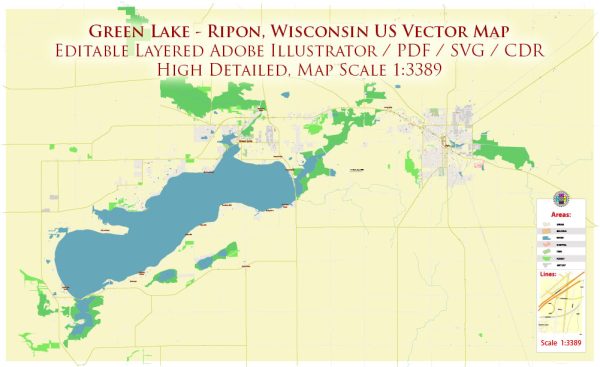Green Lake, located in Ripon, Wisconsin, has a rich history of urban development that reflects the broader trends in the growth and evolution of American communities. Here’s an overview of the historical development of Ripon and its association with Green Lake:
1. Early Settlement and Native Presence: The area around Green Lake was originally inhabited by Native American tribes, including the Ho-Chunk (Winnebago) people. European settlers began to arrive in the early 19th century, displacing Native communities.
2. Founding of Ripon: Ripon was founded in 1849 by David P. Mapes, who purchased land from the Winnebago tribe. The city’s name is said to have been inspired by Ripon in Yorkshire, England. Ripon quickly became a center for commerce and agriculture.
3. Economic Growth and Industry: Ripon’s economy grew with the establishment of industries such as milling, lumber, and manufacturing. The city’s proximity to Green Lake contributed to its development as a recreational and resort destination.
4. Role of Green Lake: Green Lake has been a significant factor in Ripon’s history. The lake attracted tourists and residents seeking leisure activities, fishing, and relaxation. Resorts and hotels were built along the lake’s shores, contributing to the local economy.
5. Tourism and Recreation: The late 19th and early 20th centuries saw a boom in tourism around Green Lake. Wealthy families from cities like Chicago and Milwaukee built summer homes along the lake, leading to the development of a vibrant resort community.
6. Architectural Heritage: Many historic buildings around Green Lake and Ripon showcase architectural styles from different eras, reflecting the changing tastes and influences on the community. These structures contribute to the area’s charm and historical character.
7. Cultural and Educational Institutions: Ripon is home to Ripon College, founded in 1851. The college has played a crucial role in the community’s intellectual and cultural development. Educational institutions often have a lasting impact on the character of a town.
8. Modern Development: In more recent times, Ripon has adapted to changing economic and social landscapes. The city has likely experienced modern urban development, including infrastructure improvements, residential expansion, and efforts to preserve its historical character.
9. Preservation Efforts: Many communities recognize the importance of preserving their historical assets. Efforts to protect and restore historic buildings and landmarks around Green Lake contribute to the town’s identity and serve as a link to its past.
Understanding the history of Green Lake and Ripon provides insight into the broader trends of American urban development, the impact of natural resources on local economies, and the evolution of communities over time.


 Author: Kirill Shrayber, Ph.D.
Author: Kirill Shrayber, Ph.D.